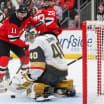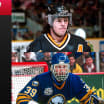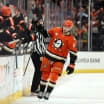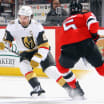The 2022 Hockey Hall of Fame induction is Monday. This year's class includes Herb Carnegie in the Builders category, as well as former players Roberto Luongo, Daniel Sedin, Henrik Sedin, Daniel Alfredsson and Riikka Sallinen. Here, NHL.com staff writer Tracey Myers profiles Sallinen.
Sallinen's historic Olympic career led to Hockey Hall of Fame
After 10-year retirement, Finland forward became sport's oldest player to win medal
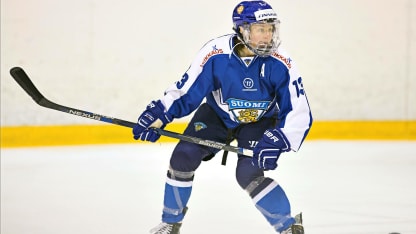
Riikka Sallinen was team manager of the Finland women's national team in 2013 when players started joking with her about making a comeback.
Sallinen had been retired from playing for 10 years, during which time she had three children.
"I took that joke a little bit too seriously," Sallinen said with a laugh during an interview last month. "I was very unsure, to be honest, if I could manage to do it or not. But I'd give it a try and my body responded in a very good way."
Indeed, Sallinen was still a strong, reliable forward during her second go-round in international competition from 2013-19. Now Sallinen will become the first European women's player to enter the Hockey Hall of Fame when she's inducted in Toronto on Monday.
"It's just the legendary career she's had, how long she played and the level she played that long at [that] makes her a Hall of Famer," said United States forward Kendall Coyne Schofield, "and a good, person too, a good competitor, a respected competitor. The way she played the game, she played it the right way. When you think of Team Finland, there are a few that come to my mind right away, and she's one of them. So, it's awesome to see her go into the Hall of Fame."
Sallinen was elected to the Hall on the first ballot.
"I played for a long time and felt I had some good longevity, but to see what she did, step away, have a few kids and come back, that's an even tougher road to do it," said former Canada forward Jayna Hefford, who played internationally from 1997-2014 and was inducted into the Hall of Fame in 2018. "To come back that long later and still be at that level is pretty impressive."
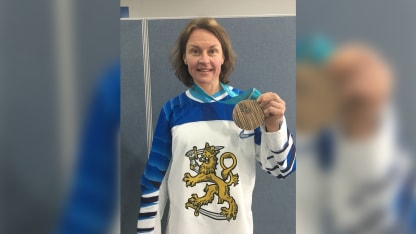
© Riikka Sallinen
Sallinen helped Finland win a bronze medal at the 1998 Nagano Olympics, the first to feature women's hockey. When Finland won bronze again at the 2018 PyeongChang Olympics, the then-44-year-old became the oldest player to win an Olympic medal in ice hockey; her countryman, Teemu Selanne, won bronze at age 43 at the 2014 Sochi Olympics. She had 25 points (12 goals, 13 assists) in 23 games across four Olympics.
Sallinen also played in eight IIHF Women's World Championships, winning seven medals -- six bronze (1990, 1992, 1994, 1997, 2015 and 2017) and one silver (2019) -- and scoring 60 points (25 goals, 35 assists) in 45 games.
She also had a long professional career, playing 11 seasons in Naisten SM-sarja, Finland's elite league, where she had 395 points (201 goals, 194 points) in 135 regular-season games, 86 points (36 goals, 50 assists) in 41 playoff games, and was a five-time champion: with Etela-Vantaan Urheilijat in 1989, with Keravan in 1994 and with JYP Jyvaskyla Naiset in 1997, '98 and 2016.
She also played three seasons between 1989-95 in the second-tier league in Finland, one season (1992-93) in Switzerland and three seasons (2016-19) in Sweden.
Former United States forward A.J. Mleczko said Sallinen exuded happiness and positivity any time Mleczko talked to her -- at least away from the rink. On the ice, it was a different story.
"She's a fierce competitor," Mleczko said. "I played two Olympics against her. Obviously, we had a big rivalry with Canada, but Finland was always nipping at our heels, pushing. Riikka, she was quick, she was feisty. I played forward in Nagano and then I played defense in Salt Lake [City] (for the 2002 Olympics), so I matched up a little bit more against her in Salt Lake. She was somebody you always had to watch out for. She always sort of popped up in places that I didn't want her to be, so she kept us on our toes."
Sallinen came back to the game a few times. As a child, she played hockey with the boys, but after getting frustrated because there were no girls teams, she stopped playing at age 12. She resumed a few years later after a girls team was established.
After leading all players at the Nagano Olympics with 12 points (seven goals, five assists), the then-25-year-old had her third and final knee surgery, which involved a cartilage transplant. Doctors told her she'd get a good knee for walking, but not hockey.
"My knee was that bad that actually I was quite satisfied if I could get a knee to live a normal active life," Sallinen said. "Then after one year [of] rehab, it was so good that the doctor said, 'OK, you can try to practice ice hockey, strength training, conditioning on the ice.' Everything went surprisingly good."
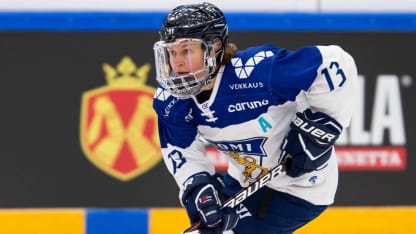
© Photo credit: Jiri Halttunen
After taking a season off, she came back to play four more seasons, including five games at the 2002 Olympics and 16 more games internationally. She retired, or so she thought, to start a family.
Ten years later, at age 40, she was back.
Tuula Puputti, former goalie for Finland, said she never doubted Sallinen could adjust after her hiatus.
"The first part of her career, she was always an offensive threat," said Puputti, now general manager of the national team. "The second part of her career the role changed a little bit, but it always helps when there is someone on your team who can put the puck in. Just overall, how she worked hard both ways on the ice, that was also something. She was ahead of her time playing."
Still, Sallinen wasn't happy with the Sochi Olympics, her first since coming out of retirement. She had five points (one goal, four assists) in four games, but Finland lost to Sweden 4-2 in the quarterfinals.
"The Olympics in Sochi came a little bit too fast for me. I wasn't that good there," she said. "But it was quite easy to make the decision to continue because it felt so good. Even though I was 40, I felt I could do better, I can be better, I can improve myself."
She did, and at the 2018 Olympics she had five points (four goals, one assist) in six games to help Finland win bronze.
"She was always really tough to play against, a 200-foot player, really good in the face-off circle, just good on puck battles too and someone who played a lot of key minutes for them for a long time," Canada forward Brianne Jenner said. "If you can play that long at that high a level, you're doing something right. Kudos to her. She probably inspired a whole generation of Finnish players."
Sallinen accomplished a lot through her two-part career. She's seen the women's game evolve, seen it grow, and she's played a big part in all of it.
"I have seen women's hockey from the start of the international competitions [in 1990], international games," she said. "I've been so privileged to be on that road, to see the improvement and what's happened with women's hockey. Those last six years, when I played, it was so great to see because those 10 years I was away from hockey, so many great things happened.
"For sure, the road is still going upward. Everyone in women's hockey wants things to improve, but so many great things have happened, and it's the players who have the greatest impact on that. Most often it's men who have power in ice hockey. We need help from them, and I'm very thankful we have those kinds of men who want to improve women's hockey too. It's been so great to be part of that journey with women's hockey and all the people I've met, all the friends I've made all over the world. It makes life worth living."
NHL.com independent correspondent Sean Farrell contributed to this report
Photo credit: Jiri Halttunen


